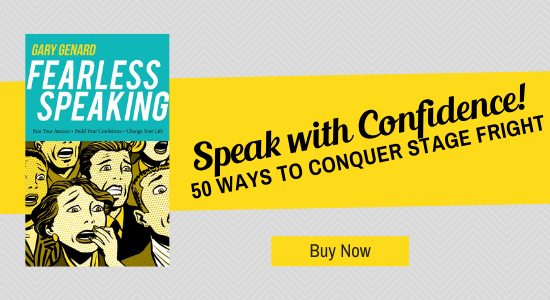
If you have fear of public speaking, you know how strong the physical effects can be. Here's how to get your own body to help you be more confident!
Fear of public speaking certainly works your mind over, doesn't it? Anxious thoughts, nervousness, negative self-talk, imagining how others are judging you . . . the mind can just be an unpleasant locale when you have speech anxiety.
In fact, part of your skewed thinking when it comes to speaking fear, is believing that your mental anguish is everything. Actually, though, there is more to this form of social anxiety than just unhelpful thoughts. Let me disagree, then, with Hamlet's assertion to Rosencrantz, that "there is nothing either good or bad, but thinking makes it so."
Is it speaking virtually that has you worried? If so, there's help! Download my Free Tips and Tricks Guide, "How to Be More Personable in Virtual Meetings."
At The Genard Method, my Fearless Speaking Course consists of three "pillars": 1. Cognitive Restructuring, 2. The Body, and 3. Focus and Presence. Why? Because public speaking is a performative activity. It's not enough to deal only with what's happening mentally, important as that is. The physical component must also be addressed. Of course, if you're not focused and mentally present as well when you speak publicly (the third pillar) you're going to be in trouble.

First, Find a Place of Stillness
But let's talk today about the second pillar: the physiological effects you experience from speech anxiety. My mantra that "you have to get out of your head and into your body" applies to all public speaking. But given the physical effects of speech fright, the need to deal with what's happening inside your body when you speak is especially important.
Learn the most powerful ways to reduce fear and become an effective speaker! Download my Free cheat sheet, "10 Fast and Effective Ways to Overcome Stage Fright."
Your body reacts in some very specific and powerful ways when the "fight or flight" response kicks in. (Actually, there's a third f-word response" that matters: "freeze," as when you realize that a predator will notice you if you move.) When the mind senses danger, the body acts instantaneously, before any time-wasting reflection can occur. Stress hormones flood into the bloodstream, and the blood itself is redistributed to muscle groups that will, indeed, help you fight or flee the danger.
This is truly a life-saving response in situations where the danger is real. Unfortunately, that's not the case when it comes to delivering a presentation. But your mind still sees a threat, and the body reacts. None of this physical super-activation is meant to be a chronic condition, however—as can be the case if you have ongoing stage fright. When released routinely, stress hormones become harmful to one's health.
Chronic fear of public speaking, then, can really beat up your body. For people who deal with it constantly, it can feel like every day is Fight Day, with its associated bruises. So my first advice is to go easy on yourself. Don't insist that this problem shouldn't be happening, for instance—that it's totally irrational. It is irrational! But you're in the grip of fear,. So start gently by being kind to yourself. Find a place inside you of quiet and stillness. Let the healing process begin.

Control Your Breathing, Control Your Response
The next step is to bring your body online to actually help you with this problem rather than work against you. The key tool here is learning controlled, healthy breathing.
This starts with knowing how to calm your nerves before speaking. Just learning that you can gain control over your breathing gives you a powerful weapon for countering your body's fearful responses. That's because doing so isn't just a mental activity, as in telling yourself, "Breathe more slowly and deeply." It's doing; in this case, breathing a certain way. You'll actually be tapping into a response that the body is already going through—you're just going to help it along and intensify it.
You do so by enlisting the help of the vagus nerve, which helps speed up or slow down your heart rate. This "wandering" cranial nerve does this automatically every time you exhale. Through a simple exercise which uses a "4-4-6-2" action (dealing with, respectively: inhalation, pausing, exhalation, and stopping the sequence), you will be extending the duration of the exhalation. Doing so slows the heart rate, leading to a calmer response which keeps you in much greater control when anxiety hits. Follow the steps I give here:
To enlist your body to stay calm, download my Free cheat sheet with the steps for the 4-4-6-2 exercise: "How Breathing Can Help Control Your Fear of Public Speaking."
Enlisting Your Nervous System's Help
Now, let's take all of this up a notch: from focusing on the heart rate, to drafting your nervous system itself to help in this campaign. The autonomic nervous system consists of the Sympathetic Nervous System (SNS) or activating component, and the Parasympathetic Nervous System (PNS) or calming response. (Also known, respectively, as the "Fight or Flight" and "Rest and Digest" systems.)
Ready to get the book named as "One of the 100 Best Confidence Books of All Time?" Get the comprehensive guide to overcoming speaking fear: Fearless Speaking.
If your SNS over-reacts when you face speech anxiety (which is the case), doesn't it make sense to try to get the PNS to kick in? Of course it does. And you won't believe how simple and easy it is. Once again, you'll be using breathing as the key mechanism; and this time, it involves simply pursing the lips when you exhale.
This is called "resistance breathing," and it works in two ways: (1) Because you've created a smaller opening, it will take longer to exhale the air in your lungs. As I explained above, extended exhalation means both more control over the respiration cycle, while helping slow the heart rate and aiding "heart variability." (2) Resistance breathing also improves your ability to stay in the present, i.e., to inhabit the present moment, because you WILL be in the present if you focus on your breathing.
Intrusive, negative thoughts—and the stress response they help elicit—are ever-present villains for anyone who experiences speech anxiety. Such thoughts always take you out of the present and inhibit your ability to react to the moment and perform at your best. By keeping you in the present, resistance breathing helps you develop mindfulness. And mindfulness turns on the Parasympathetic Nervous System. It's one more way of getting your own body to help you overcome fear of public speaking.
You should follow me on Twitter here.
Discover 50 Ways to Conquer Stage Fright! Click on the image below.
Gary Genard is an actor, author, and expert in public speaking training and overcoming speaking fear. His company, Boston-based The Genard Method offers live 1:1 Zoom executive coaching and corporate group training worldwide. In 2021 for the eighth consecutive year, Gary has been ranked by Global Gurus as One of the World’s Top 30 Communication Professionals. He is the author of the Amazon Best-Seller How to Give a Speech. His second book, Fearless Speaking, was named in 2019 as "One of the 100 Best Confidence Books of All Time." His latest book is The Online Meetings Handbook, now available at The Genard Method and at Amazon. To know more about TGM's services, Contact Gary here.




